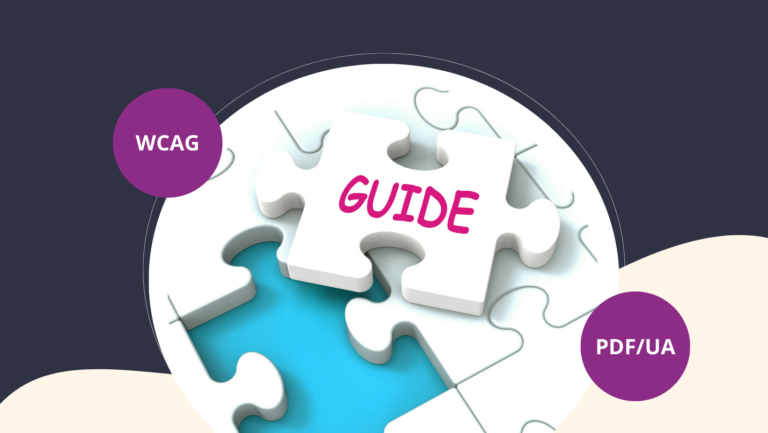Find out more about the importance of implementing the EAA, accessibility issues and potential loopholes. Read more in our article.
The EAA is one of the European regulations to be transposed into national law – the DADUE Act of 9 March 2023, which specifically focuses on implementing the EAA in France. This directive is an important milestone, firstly to encourage accessibility initiatives, and secondly to ensure compliance with accessibility standards, with tougher penalties (in the event of non-compliance). However, there are still several questions surrounding the implementation of measures in France. Let’s take a closer look at them.
European accessibility law: criteria and compliance levels
By 2025, “all e-commerce sites and platforms must be accessible for new services”. 2030, for existing services.
The problem: a site that is considered “accessible” today must be 100% compliant with the RGAA, but very few sites meet this requirement. Most of the companies concerned find the process of making their sites accessible too complex. As a result, they prefer to pay the fine rather than commit to making their services accessible.
What’s more, even though the law introduced a minimum threshold of compliance, all of the RGAA’s criteria are now given equal weight in the calculation of the accessibility score. In other words, a website with a score of 90% may not be keyboard accessible.
There are two solutions:
- To validate a site as “accessible”, rely on certain specific criteria in the rating system. For example, accessible keyboard navigation with constant focus visibility. Or the transcription of all visually available information to the screen reader (images, buttons or links texts, etc.).
If the site does not meet these criteria, it may automatically be considered non-compliant.
- It is also possible to improve the rating calculation by taking more seriously the criteria that are most important to the user. Such as zooming in up to 200% without loss of information.
Details expected on office documents
Besides digital platforms (websites, applications, etc.), we are expecting further details from the implementing Directive on office documents. More specifically, electronic communications and current documents.
Most of these documents are sent in PDF format.Invoices, pay slips, bank statements, sales presentations, information leaflets… All these PDF documents are ubiquitous in our daily lives. However, many people still find it difficult to access and consult these files on their own.
The transposition text encourages the use of accessible documents without providing clear guidance on the formats to be used to ensure this accessibility.
As the regulations currently stand, we recommend the PDF/UA standard as support. This meets several compliance criteria and is an international reference supported by the PDF Association. Tools are available to validate compliance and, to date, this standard remains the most effective in ensuring optimal quality of service.
In addition, although the PDF/UA format has certain limitations, particularly regarding contrast and typography, there are alternatives for generating accessible HTML versions from a tagged PDF document.
Failure to coordinate inspection bodies
To date, no cases of non-compliance with the RGAA have been reported.
The transposition has defined the control bodies and their functions to ensure compliance with the accessibility obligations. For example, DGCCRF for the e-commerce sector or Banque de France, which is responsible for authentication and electronic signature systems.
Although these bodies are highly competent in their fields, they are not necessarily familiar with the requirements of digital accessibility.
Implementing digital accessibility goes far beyond simply understanding the existing challenges. It is essential to understand the reference frameworks and the technical, graphical and editorial aspects that are applicable. A period of adaptation is necessary before these controls are established and any penalties applied.
Working with accessibility agencies and specialists will be essential to facilitate the implementation and maintenance of accessibility.
The main aim of the European Directive is to ensure a consistent level of accessibility across Europe. As the market expands and demand grows, competition will inevitably increase. And hopefully, this will lead to even higher levels of quality and standards of accessibility.
Note: Most initial digital training courses (development, project and design) do not talk much about accessibility issues. Even if they can learn how to perform accessibility testing using a repository, it is crucial to assess the criticality and prioritisation of non-compliance about their impact on the user. This will make it easier to implement a compliance strategy and apply best practices more effectively.
What next? Looking into the future.
Ipedis is committed to putting the user first in every project. We firmly believe that the ideas presented here deserve to be explored in greater depth.
The expected legislative changes will play a crucial role in ensuring the coherence of the regulatory framework and sanctions related to accessibility, thus avoiding non-compliance with the laws in force. Some organisations have already adopted a more inclusive approach by actively integrating the needs of users into their operations. Others are lagging.
Strengthening legislation in Europe should spur public and private organisations into action. We sincerely hope that this will raise awareness of the importance of disability and the need for digital accessibility in our society.













